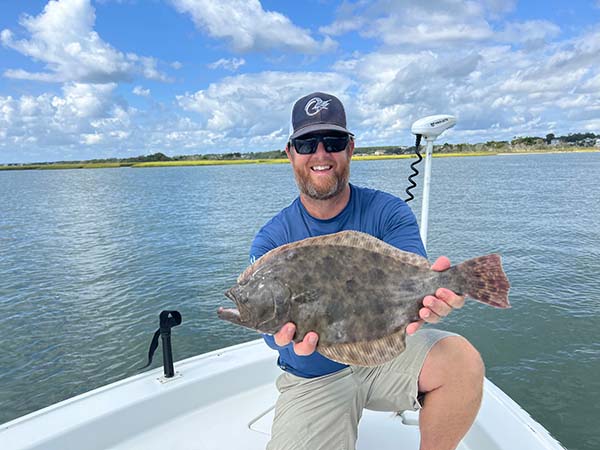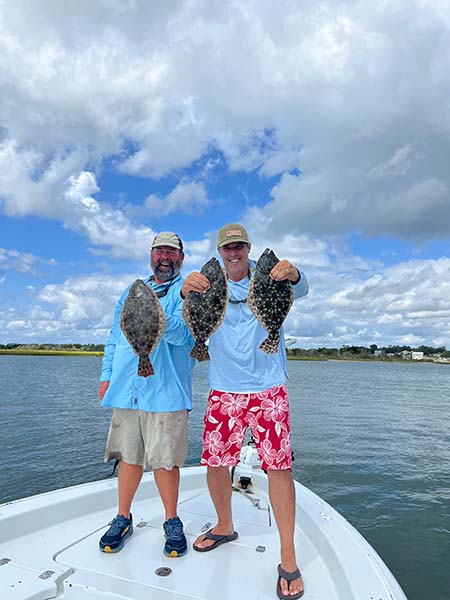Tidelines – October 2022
September is a busy month for Fisherman’s Post, between the Labor Day holiday and hosting the Carolina Beach Inshore Challenge, the Trail Championship, and the Hatteras Island Surf Fishing Challenge, and that busy schedule meant it was hard for me to get in some keeper flounder fishing.
Luckily, Capt. Mike Oppegaard, of Native Son Guide Fishing out of the Topsail area, had left a half day free for us to leave out of New Topsail Inlet to target nearshore flounder on some of the productive bottom just off the beachfront.
Our Plan A was to head out about four miles to a little known area that Mike has saved on his machine, but a couple of waves over the bow coming out of the shallow inlet, followed by a couple more coming over the bow as we made way almost directly into the swell, meant a Plan B was needed.
That Plan B was to stay much closer to shore and hit the Topsail Inshore Ledges, a section of live bottom in 35-45’ of water not too far off of Jolly Roger Pier, and hope the north/northeast wind would be at least a little blocked by the coast.
It’s debatable at best whether or not the waves were any less, but without running, we were no longer taking waves over the bow, so Mike started looking closely at his machine for the thick, red, broken bottom that he wanted.
With the GPS trolling motor now in the water and our bow facing into the wind, Mike hit the spot lock and grabbed some rods he already had tied and handed them over to me and Tom, my brother-in-law that had never been nearshore flounder fishing.
“I like the TFO Inshore Tactical 7-foot rod,” he explained as he checked the knots connecting the 20 lb. braid to the 30 lb. leader, the leader itself, and the knot connecting the leader to a 2 oz. jig head. “The ones we are using today are heavy action. They have good Fuji guides, good action, and they’re very durable.”
My jig head was rigged with a 5” Z-Man DieZel MinnowZ in the Golden Boy color, Tom’s was in the Pinfish color, and to both Mike added some menhaden Pro-Cure. The instructions were simple: drop straight down. We didn’t need to cast to cover water because Mike would be using the spot lock to drift us back in 5-10’ increments.
“I fish vertically,” Mike explained, “because if you cast out and bring your jig back to the boat over the rocks we’re fishing, you’re going to spend your time getting unhung. If you fish vertically, the jig is going to be bouncing up and down on the rocks and not across them. You’re still going to get hung up fishing vertically, just not nearly as much.”
Tom, never shy to ask a question, wanted to know what to do after dropping straight down.
“Drop the jig all the way to the bottom, feel it hit, tighten up the line just a bit so that you can feel the jig, and then pop the jig 2-3 inches and pop it that way 3 or 4 times in a row,” Mike, never shy to answer a question, gladly told Tom.

“We do small pops of 2-3 inches done 3 to 4 times in arrow,” Mike continued, “because I think it helps the tail of the soft plastic to wobble more and look more lively.”
He added as we flipped the bail to drop the jig head and soft plastic, “And lots of times you’re getting hit on the drop, so if you don’t maintain contact by controlling the speed of the drop, then you won’t feel the bite.”
Our other instruction was not to wait to set the hook if we feel a bite, and when we set the hook, set the hook hard.
Bill Dance would not have been impressed at all, but apparently I set the hook hard enough. My rod was bent over, and I was steadily reeling up a fish. We questioned whether it was our target species or one of the common undesirables, such as a small black sea bass or a lizardfish. A few good head shakes about midway up the water column gave both Mike and me confidence, so he grabbed the net. We had our first keeper in the livewell, a 2+ lb. southern, less than 10 minutes into jig fishing for nearshore flounder.
Tom’s turn, after a few of those undesirables and even an octopus, came soon enough. His rod was bent down more significantly than it had been with the sea bass and oyster toads, and when we saw the head shakes, Mike grabbed the net.
Tom, who we’ve already noted isn’t shy to ask a question, should have asked what to do when you successfully hook a flounder and bring that flounder up to the surface. Just as Mike, who we’ve already noted isn’t shy about answering questions, should have anticipated the matter of what to do with a flounder once it’s at the boat. Either way, it would have been a better conversation to have before the flounder was half in and half out of the water.
No, we didn’t lose the flounder, but we almost did.
“If the flounder can get it’s head above the surface,” Mike shared with Tom, after the flounder threw the hook but luckily didn’t throw it until the net was underneath, “they can easily shake the hook loose. When the flounder is in the water, the water gives enough extra resistance that the flounder can’t use the weight of the jig as a lever to throw it.”
We caught several ocean flounder over the morning, culling out our heaviest three, and culling with confidence because Mike has a big livewell to keep fish healthy to reduce release mortality.

“I like fishing nearshore for flounder better than fishing inshore,” Mike shared, once we were inside the inlet and back in calm waters, “because nearshore fish aren’t as pressured, and here in the Topsail area, I feel like nearshore has better numbers and more of the bigger fish.”
“And I like artificials better than live bait,” he continued, now opening up the throttle a bit on his 22’ Lake & Bay powered by a 250 Suzuki, “because they cover more ground, catch less trash fish, and for me have a better strike to landed ratio.”
This Tidelines article is appearing in the October issue, so by publication date the keeper flounder season will be over. You can still enjoy nearshore flounder fishing with Capt. Mike Oppegaard, of Native Son Guide Service, even if the season isn’t open for keeping fish, or you can book him for his two main fall pursuits—red drum and trout (with an albacore or two thrown in).
Give Mike a call at (910) 233-8295 or visit him online at www.nativesonguideservice.com and ask about your own fall trip. I suggest a call, of course. Just don’t be shy…and I’m sure Mike will do his part.





